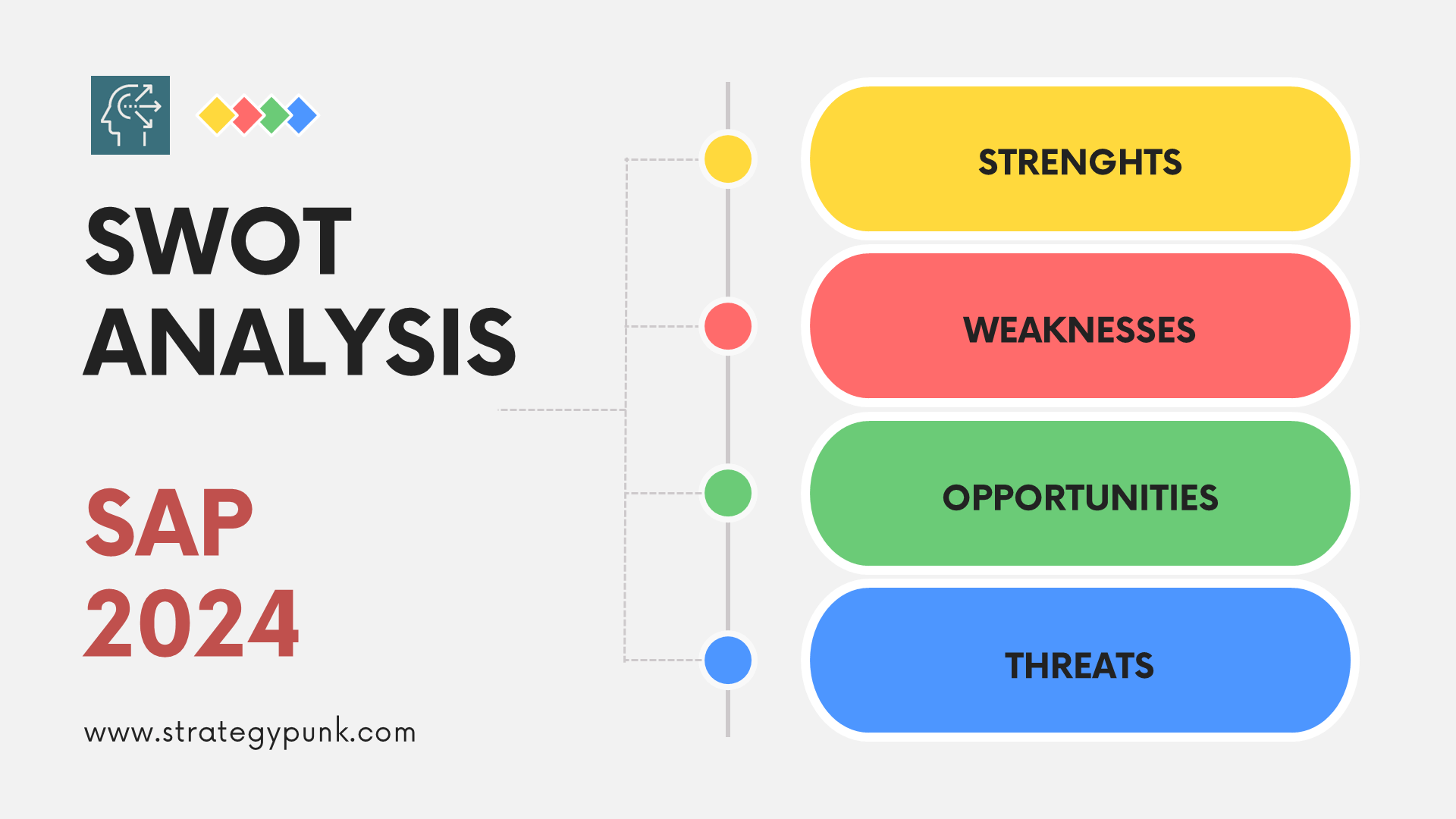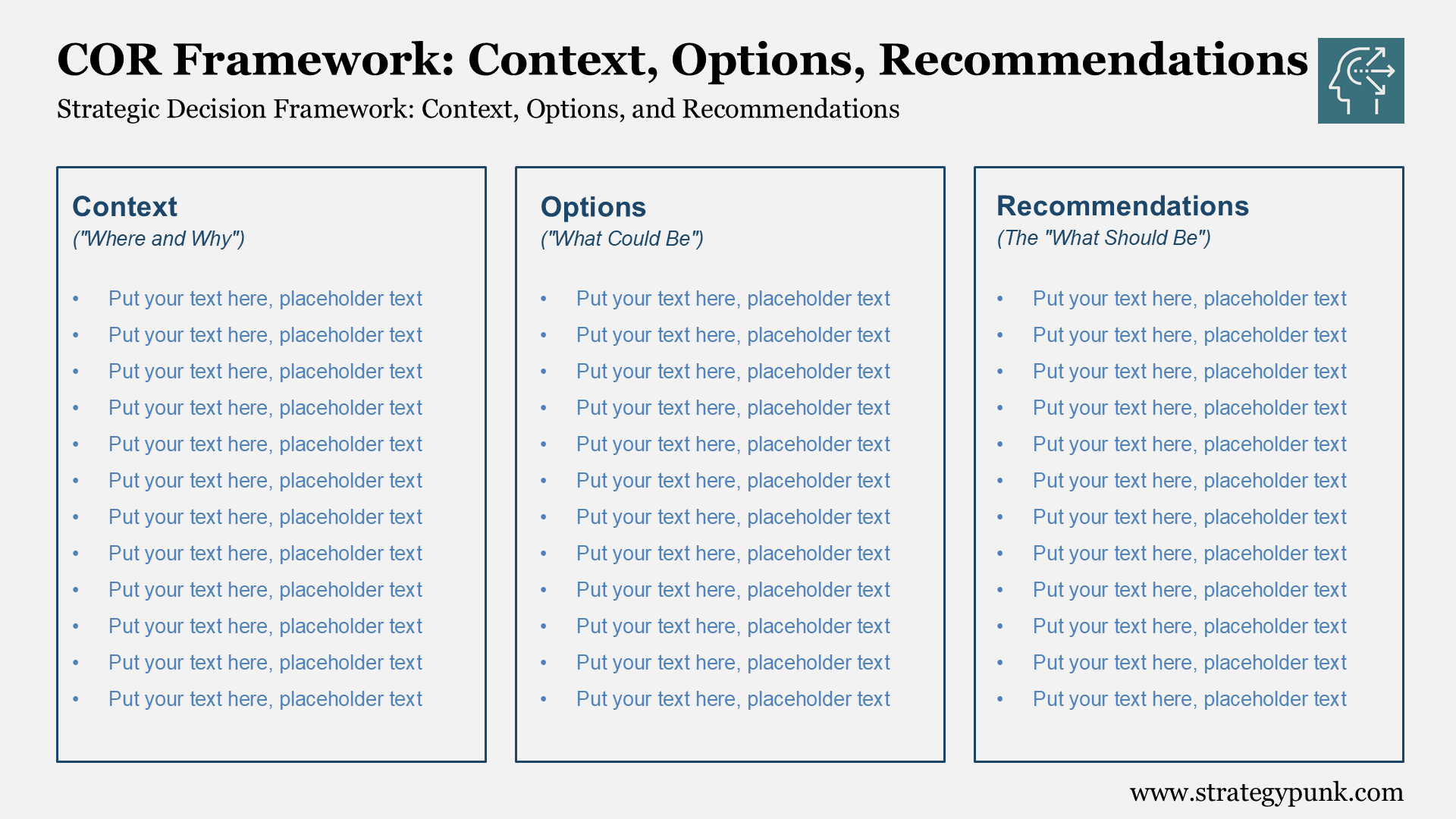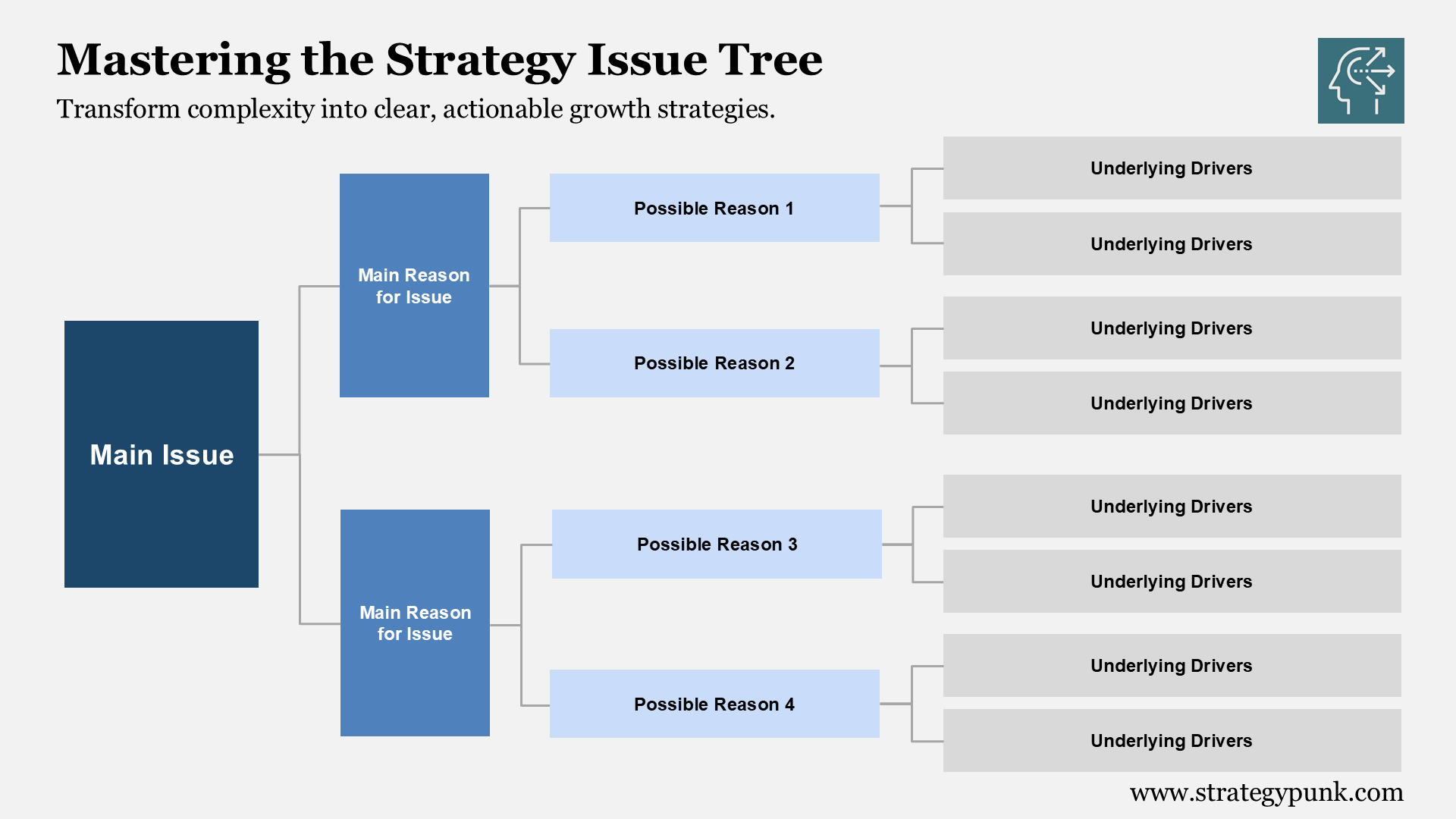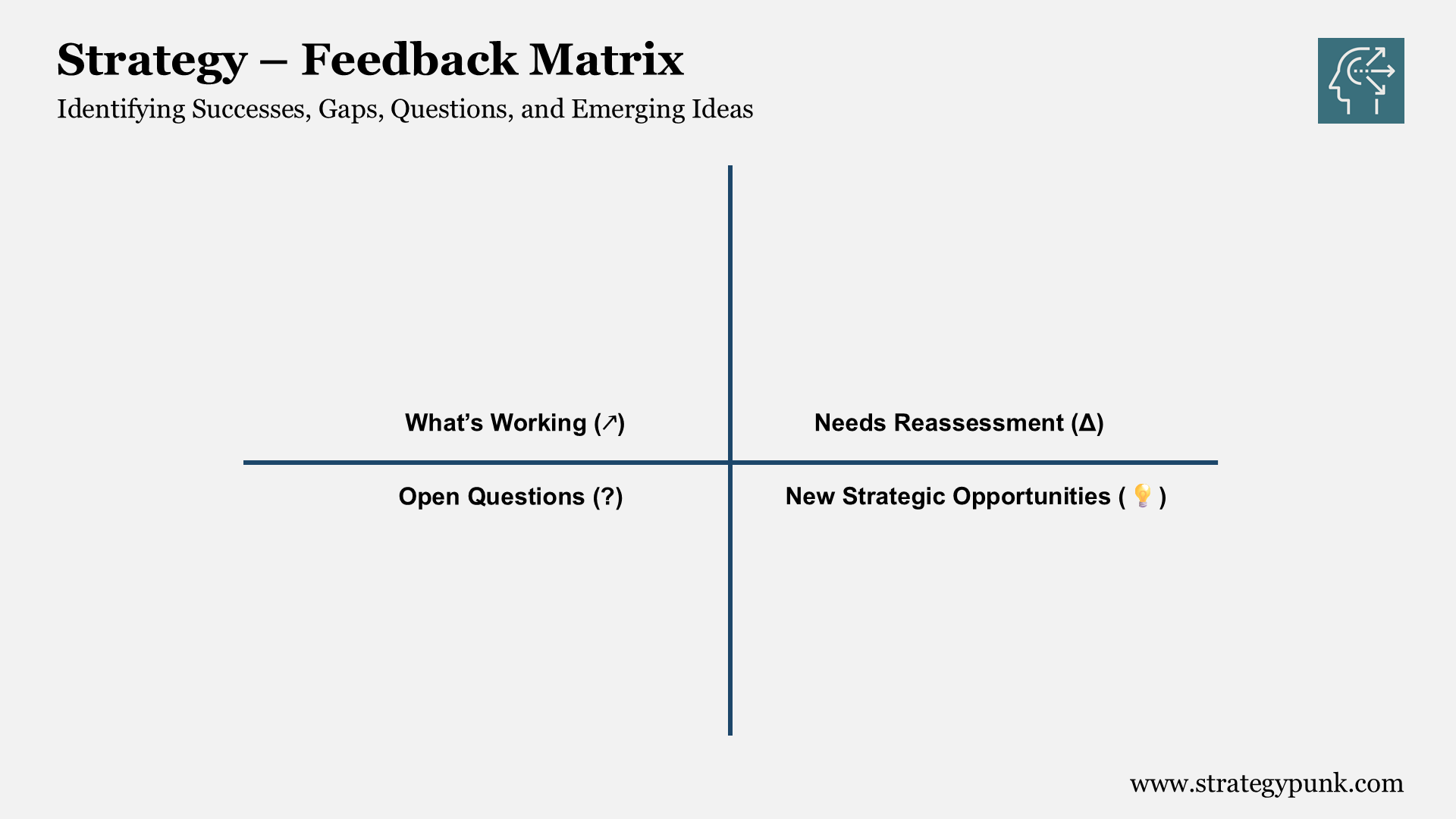Strategic Insights 2024: A SWOT Analysis of SAP (incl. FREE PPT)
Explore SAP's future with our Strategic Insights 2024: SWOT Analysis. FREE PowerPoint template included. Gain key strategies for growth.

Introduction
The global software market is undergoing rapid transformation, with companies facing opportunities and threats from emerging technologies like cloud, AI, and automation. As the market leader in enterprise application software, SAP sits at the epicenter of these changes.
This blog post will analyze SAP's strengths, weaknesses, opportunities, and threats to understand its strategic position in 2024 and beyond. We'll also look at its business model, financial performance, and strategies for continued growth. A free PowerPoint and PDF template can be downloaded at the end of the post.
A Brief History of SAP
Before diving into the SWOT analysis, it's helpful to understand SAP's origins. SAP was founded in 1972 by five former IBM employees in Germany. They envisioned creating standard enterprise software to integrate business processes across departments.
In the 1980s, SAP launched its R/3 software for client-server environments. This allowed companies to view operations as integrated processes with real-time data flows. SAP quickly became the global standard for ERP software.
Over the past 50 years, SAP has grown to over 400,000 customers worldwide. It has expanded from ERP into business intelligence, databases, mobile, and cloud through organic product development and critical acquisitions of companies like SuccessFactors, Ariba, and Qualtrics.
Today, SAP offers end-to-end solutions to help enterprises run integrated digital business processes across departments - positioning itself as an essential business partner for the modern age.
What is SAP's Business Model?
At its core, SAP utilizes an enterprise software license model. Customers purchase licenses to use SAP software based on metrics like number of users, transactions, revenue, or data volume. Software is hosted either on-premise or in SAP's cloud.
In recent years, SAP has focused on transitioning its business model to cloud-based subscriptions. Cloud revenue comprised 22% of SAP's total in 2022 but is targeted to account for over 30% by 2025.
In addition to software licenses and subscriptions, SAP monetizes software support, consulting services, and business network transactions from Ariba and other SAP platforms.
Financials of SAP
Despite economic challenges, SAP delivered a steady financial performance in 2022:
- Total revenue: €30.9 billion, up 11%
- Cloud revenue: €12.6 billion, up 34%
- IFRS operating profit: €6.4 billion
- Non-IFRS operating profit: €8 billion
SAP is projecting strong cloud growth to continue, with cloud revenue accelerating to €22-24 billion by 2025, buoyed by strong demand for its "RISE with SAP" integrated cloud suite.
Operating margins are expected to expand through efficiency gains, scaling its cloud business, completing its cloud transformation program, and contributions from Qualtrics.
In-depth SWOT Analysis of SAP 2024

Now let's examine SAP's strengths, weaknesses, opportunities, and threats heading into 2024:
SAP’s Strengths
- Global customer base and partnerships: SAP has unmatched scale and relationships with over 400,000 customers across 180+ countries and a network of over 22,000 partners.
- Broadest enterprise application portfolio: SAP offers the most comprehensive portfolio spanning all critical business functions like ERP, CRM, HR, spend management, and business intelligence.
- Industry expertise: After 50 years, SAP has cultivated deep industry-specific functionality, expertise, and partnerships across 25+ industries.
- Trusted brand: SAP is synonymous with enterprise software and runs mission-critical systems for 77% of Forbes Global 2000 companies. Its brand commands trust and loyalty.
- Financial strength: With high recurring revenue and operating cash flows, SAP possesses tremendous financial resources to invest in growth. Its balance sheet carries little debt.
SAP’s Weaknesses
- Complexity: With a vast product portfolio, SAP solutions can be overly complex for customers to implement, manage, and update.
- Cloud transition: Despite solid cloud growth, most of SAP's 400K customers still use its on-premise software. Migrating these customers to the cloud remains a lengthy and costly process.
- Innovation velocity: Critics argue SAP has been slow to deliver cutting-edge innovations in its core ERP and database products compared to competitors.
- Go-to-market execution: As an enterprise sales organization at its core, SAP has room to improve efficiency and alignment across its broad solution portfolio and routes-to-market.
SAP’s Opportunities
- RISE with SAP: SAP's integrated cloud suite provides a significant growth opportunity to migrate existing customers and attract new ones.
- S/4HANA momentum: As customers upgrade legacy ERP systems, SAP is well positioned to cross-sell S/4HANA - its next-gen intelligent ERP platform.
- Qualtrics spin-off: The pending spin-off of the Qualtrics experience management unit could unlock shareholder value.
- Industry cloud expansion: With early traction in industry clouds for sectors like retail, automotive, and utilities, SAP has a greenfield opportunity for continued growth.
- Business process intelligence: Embedding intelligence into business processes leveraging SAP's data and AI capabilities represents a sizeable opportunity.
SAP’s Threats
- Cloud competition: As legacy software incumbents like Oracle and new entrants like Workday shift focus to the cloud, competition is intensifying.
- Microsoft: With Azure and Dynamics 365, Microsoft is positioned as an end-to-end cloud alternative for business applications and infrastructure.
- Margin pressures: The transition towards cloud and SaaS revenue streams brings the potential for margin compression in coming years.
- Macroeconomic environment: Economic weakness, inflation, rising interest rates, and supply chain volatility could curb enterprise software spend.
- Complacency: After 50 years at the top, SAP faces the threat of complacency, allowing hungry competitors to gain ground.
SAP SWOT Analysis Summary

In summary, SAP retains significant competitive advantages heading into 2024 - including unrivaled scale, customer relationships, brand equity, solutions breadth, and financial strength.
Threats emerge from multiple fronts as the enterprise software market transforms rapidly. SAP must leverage its strengths while addressing weaknesses in strategic areas like cloud innovation and sales execution to maintain its leadership.
Internal Factors
SAP's internal strengths and weaknesses highlight both its enviable market position and the need for improvement:
Strengths
- Global customer base, partnerships, brand equity
- Broadest enterprise application portfolio
- Industry expertise and functionality
- Strong financial profile
Weaknesses
- Portfolio and implementation complexity
- Slow pace of cloud transition
- Lagging pace of innovation in some areas
- Suboptimal go-to-market execution
External Factors
Externally, SAP faces a mix of promising opportunities but also intensifying competitive threats:
Opportunities
- RISE with SAP cloud suite
- S/4HANA migration and expansion
- Qualtrics spin-off potential
- Industry cloud momentum
- Embedded business intelligence
Threats
- Increasing cloud competition
- Microsoft bundling Azure with Dynamics 365
- Margin pressures from cloud shift
- Tough macroeconomic environment
- Complacency allowing rivals to catch up
SAP's strategies for success
SAP's focus on organic revenue growth from its existing customer base is vital to success. They are constantly working to expand product scope and move customers to fuller solution suites. Acquisitions, partnerships, and industry expertise also play a role in SAP's strategy.
SAP Cloud Strategy
- Focused on moving all SAP applications and solutions to the cloud. The financial target is €22 billion in cloud revenue by 2025.
- Offers flexibility for customers to choose a cloud provider while SAP manages services. Partners with hyperscalers like AWS, Azure, and GCP.
- Core offerings are RISE with SAP for large enterprises and GROW with SAP for SMEs to simplify cloud migration.
AI Strategy
- Goal is to lead in "AI Built for Business" and expand market potential to $27.5 billion. Currently, there are over 300 AI use cases.
- Leveraging partnerships with Google, Microsoft, and IBM to enhance AI capabilities. Also developing in-house AI like new copilot "Joule."
- Focus on embedding AI into core business processes across the SAP solutions portfolio from finance to supply chain to HCM.
Industry Strategy
- 25+ vertical solutions across industries like mining, manufacturing, higher education, etc.
- Combination of internal development, customer input, partners, and clever packaging of solutions.
- Planning to expand presence in non-manufacturing industries like retail, insurance, banking, etc.
Platform Strategy
- Dates back to 2003 NetWeaver platform for integration and development.
- Continued enrichment of modeling and composition tools, plus services repository.
- Building momentum and market acceptance.
Frequently Asked Questions
What is SAP's overall business strategy for the next 5 years?
SAP's strategy is focused on moving customers to the cloud and becoming an intelligent, sustainable enterprise. Key initiatives include RISE with SAP for large enterprises and GROW with SAP for SMEs to help companies transition to SAP's cloud solutions. SAP is also focused on sustainability by providing visibility into supply chain emissions.
What is SAP's most significant weakness?
SAP's most pressing weakness is the slow transition of its large install base of on-premise software customers to the cloud. Migrating 400,000+ customers is an immense challenge.
What is SAP's most significant opportunity?
SAP's RISE with SAP integrated cloud suite represents its most significant growth opportunity to both migrate existing on-premise customers and attract new cloud-native customers at scale.
Is Microsoft a significant threat to SAP?
With Azure and Dynamics 365, Microsoft does pose an emerging threat - uniquely able to bundle cloud infrastructure and business applications together. SAP will need to enhance partnerships with hyper scalers like Microsoft.
Will economic weakness impact SAP?
Lingering economic weakness poses some risk to SAP if enterprises curb software spending. However, mission-critical solutions like ERP are more insulated than discretionary software projects.
What is SAP's strategy for growth through mergers and acquisitions?
SAP looks for acquisition targets to expand our solutions portfolio, extend our reach into new markets and industries, and bring in talent and technology innovation. SAP has a disciplined approach to evaluating deals to ensure they support our overall cloud growth strategy. Recent examples include the acquisitions of Taulia, AppGyver, and Signavio.
What leadership qualities are essential for SAP?
Critical leadership qualities for SAP include being a strong communicator and listener, having business and technical expertise, being adaptable to change, focusing on customer needs, and leading with transparency. Leaders must also understand risk, prepare thoroughly, and focus on credibility.
SAP SWOT Analysis PowerPoint Template
free and fully editable PPT template
A SWOT analysis evaluates the strengths, weaknesses, opportunities, and threats impacting a company.
This free editable PowerPoint template provides a SWOT analysis framework to evaluate SAP's internal strengths and weaknesses and external opportunities and threats.
SAP SWOT Analysis PDF Template
SAP SWOT Analysis PowerPoint Template
Feel free to customize the template by adding your content, images, and visuals.
Discover more
Salesforce SWOT Analysis: Free PPT Template and In-Depth Insights 2024
Unlock the potential of Salesforce in 2024 with our in-depth SWOT analysis. Explore a detailed examination of Salesforce's strengths, weaknesses, opportunities, and threats within the CRM and cloud computing arenas.

SWOT Framework & Free PPT Template - 2024 Edition
Dive into the 2024 Edition of our SWOT Analysis guide, complete with a free PowerPoint template. This resource covers the essentials of conducting SWOT analysis, its benefits, and practical application tips, including a case study on Mercedes Benz.

Fastly SWOT Analysis: Free PPT and In-Depth Insights 2024
2024 SWOT Analysis of Fastly with free, detailed PPT guide and insights.







